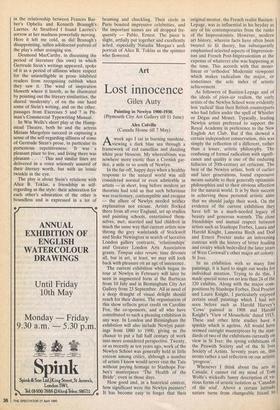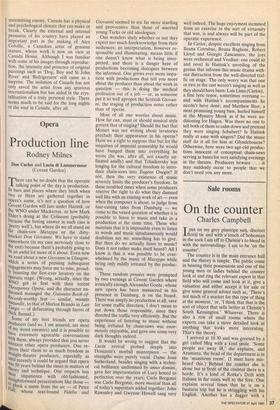Art
Lost innocence
Giles Auty
Painting in Newlyn 1900-1930. (Plymouth City Art Gallery till 11 June) Alex Colville (Canada House till 7 May)
A week ago I sat in burning sunshine, .Aviewing a dark blue sea through a framework of red camellias and dazzling white pear blossom. My whereabouts was nowhere more exotic than a Cornish gar- den, a mile or so south of Newlyn.
In the far-off, happy days when a healthy response to the natural world was still considered normal or even admirable in artists — in short, long before modern art theorists had told us that such behaviour was reactionary, contemptible and escapist — the allure of Newlyn needed neither explanation nor excuse. Artists flocked there from all over England, set up studios and painting schools, entertained them- selves, met, married and had children in much the same way that current artists now throng the grey wastelands of Stockwell and Stoke Newington in search of lucrative London gallery contracts, 'relationships' and Greater London Arts Association grants. Tempus edax rerum; time devours all, but in art, at least, we may still look back with pleasure on an age of innocence.
The current exhibition which began its tour at Newlyn in February will later be seen in augmented form at the Barbican from 10 July and in Birmingham City Art Gallery from 23 September. All in need of a deep draught of visual delight should reach for their diaries. The organisation of this show reflects great credit on Caroline Fox, the co-sponsors, and all who have contributed to such a pleasing exhibition in any way. In London and Birmingham the exhibition will also include Newlyn paint- ings from 1880 to 1900, giving us the chance to put a full half century of work into more considered perspective. Twenty, or as recently as ten years ago, work of the Newlyn School was generally held in little esteem among critics, although a number of artists I know would never visit the Tate without paying homage to Stanhope For- bes's masterpiece 'The Health of the Bride', even in those days.
How good and, in a historical context, how significant were the Newlyn painters? It has become easy to forget that their original mentor, the French realist Bastien- Lepage , was as influential in his heyday as any of his contemporaries from the ranks of the Impressionists. However, modern art history, wherein facts have often been twisted to fit theory, has subsequently emphasised selected aspects of Impression- ism and French Post-Impressionism at the expense of whatever else was happening at the time. This accords with that mono- linear or 'orthodox' Modernist viewpoint which makes radicalism the major, or sometimes the sole index of artistic achievement.
As followers of Bastien-Lepage and of the ideals of plein-air realism, the early
artists of the Newlyn School were evidently less 'radical' than their British counterparts who had fallen under the spell of Whistler or Degas and Monet. Typically, leading Newlyn artists preferred to support the Royal Academy in preference to the New English Art Club. But if this showed a certain independent conservatism, this was simply the reflection of a different, rather than a lesser, artistic philosophy. The confusing of formal radicalism with signifi- cance and quality is one of the enduring fallacies of 20th-century art criticism. The best of the Newlyn artists, both of earlier and later generations, found expressive
means suitable to their generally optimistic philosophies and to their obvious affection for the natural world. It is by their success in achieving these personal artistic aims that we should judge their work. On the evidence of the current exhibition they have left us a much-needed legacy of beauty and generous warmth. The close friendships and mutual respect between artists such as Stanhope Forbes, Laura and Harold Knight, Lamorna Birch and Dod and Ernest Procter make an interesting contrast with the history of bitter feuding and rivalry which bedevilled the later years of West Cornwall's other major art colony: St Ives.
In an exhibition with so many fine paintings, it is hard to single out works for individual mention. Trying to do this, I made special notes on no less than 24 of the 120 exhibits. Along with the major com- positions by Stanhope Forbes, Dod Procter and Laura Knight, I particularly enjoyed certain small paintings which I had not seen before such as Harold Harvey's `Cows' painted in 1908 and Harold Knight's 'View of Mousehole' dated 1915. These and other little studies have a sparkle which is ageless. All would have seemed outright masterpieces by the stan- dards of two of the exhibitions currently on view in St Ives: the spring exhibitions of the Penwith Society and of the St Ives Society of Artists. Seventy years on, this seems rather a sad reflection on our artistic `progress'.
Whenever I think about the arts in Canada, I cannot rid my mind of Torn Wolfe's wickedly funny description of va- rious forms of artistic isolation as `Canadas of the soul'. Above a certain latitude nature turns from changeable friend to
unremitting enemy. Canada has a physical and psychological climate that can make or break. Clearly the external and internal pressures of his country have played an important part in the making of Alex Colville, a Canadian artist of genuine stature, whose work is now on view at Canada House. Although I was familiar with some of his images through reproduc- tion, the intensity and presence of original paintings such as 'Dog, Boy and St John River' and 'Refrigerator' still came as a surprise. The isolation of Canada has not only saved the artist from any spurious internationalism but has aided in the crys- tallisation of a truly personal style. There seems much to be said for the long nights of the soul in Canada, after all.



















































 Previous page
Previous page